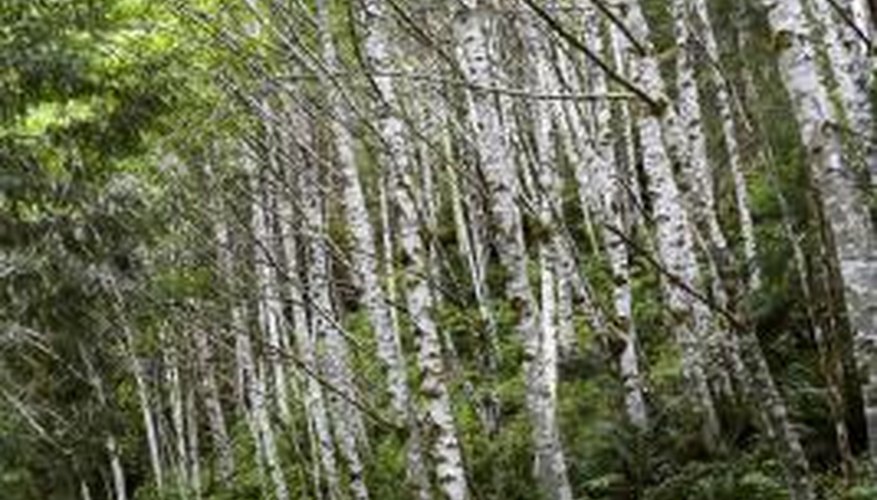Of the 60 species of birch trees (Betula spp.) native to the cold winter and cool summer regions of the Northern Hemisphere, those chosen for garden use display colourful, paper-like or shredding bark and tend to have yellow fall autumn colour. Companion plants grown in association with a birch tree need to complement -- not hide or visually overpower -- the ornamental features of the birch and grow in a climate and soil that already favours the birch tree. Birch trees prosper in fertile, moist, well-drained soils in full sun or lightly dappled shade.
Ground covers
One of the simplest and most effective design ideas to show off a birch tree is to plant a uniform carpet of ground cover around the tree's base. Whether the birch is a solitary specimen or planted in a grove-like cluster, a low-growing ground cover planting unifies the planting area and helps accentuate the vertical habit of the birch. The ground cover also provides a subtle backdrop so visitors focus on the branches and ornamental bark of the birch tree. The range of possible plant species to use as ground cover is large and depends on soil quality and moisture as well as how much light the birch tree allows to reach the ground beneath. Try ground cover plants such as bugleweed (ajuga), plantain lily (hosta), foamflower (tiarella), lilyturf (liriope), tickseed (coreopsis), creeping juniper or sprawling stems of Boston ivy, English ivy or spurge (pachysandra).
- One of the simplest and most effective design ideas to show off a birch tree is to plant a uniform carpet of ground cover around the tree's base.
- The range of possible plant species to use as ground cover is large and depends on soil quality and moisture as well as how much light the birch tree allows to reach the ground beneath.
Evergreens
Contrast the birch tree's form by planting evergreen shrubs or trees. Birch trees are particularly showy in winter, when the tree's silhouette is obvious and an unimpeded view of the bark exists. A background of a dark green evergreen hedge or trees like white pine, Austrian pine, hemlock or arbor vitae accentuates the lighter-coloured branches and trunk of the birch. Moreover, evergreen shrubs scattered around the base of a birch tree help provide visual colour and structure to complement the upright trunk. Juniper, mugo pine (Pinus mugo), dwarf blue spruce (Picea), dwarf false cypress (Chamaecyparis) and Russian arbor vitae (Microbiota) are but a few needled evergreen shrubs to grow near a birch tree.
- Contrast the birch tree's form by planting evergreen shrubs or trees.
- A background of a dark green evergreen hedge or trees like white pine, Austrian pine, hemlock or arbor vitae accentuates the lighter-coloured branches and trunk of the birch.
Flowering shrubs
Birch trees produce rather modest pendant catkin flowers in early spring, but for the most part they aren't considered an ornamental flowering tree. Once the birch tree's leaves return in spring and summer and gardeners overlook the beauty of the birch, a few strategically placed flowering shrubs bring interest back to the area around the tree. Choose round-shaped shrubs to contrast with the vertical habit of the birch, and plant taller shrubs behind the birch and shorter, petite flowering plants in the foreground. Use dwarf lilac (Syringa), rhododendron/azalea, viburnum and spiraea. While the flowers of winterberry holly (Ilex verticillata), blueberry (Vaccinium), beautyberry (Callicarpa) and red-twig dogwoods (Cornus sericea) shrubs are overlooked, the wintertime berries or leafless coloured stems provide a visual contrast to the ornamental bark of the birch tree, too. This makes the entire planting area around the birch a striking highlight in autumn and winter.
- Birch trees produce rather modest pendant catkin flowers in early spring, but for the most part they aren't considered an ornamental flowering tree.
- While the flowers of winterberry holly (Ilex verticillata), blueberry (Vaccinium), beautyberry (Callicarpa) and red-twig dogwoods (Cornus sericea) shrubs are overlooked, the wintertime berries or leafless coloured stems provide a visual contrast to the ornamental bark of the birch tree, too.
